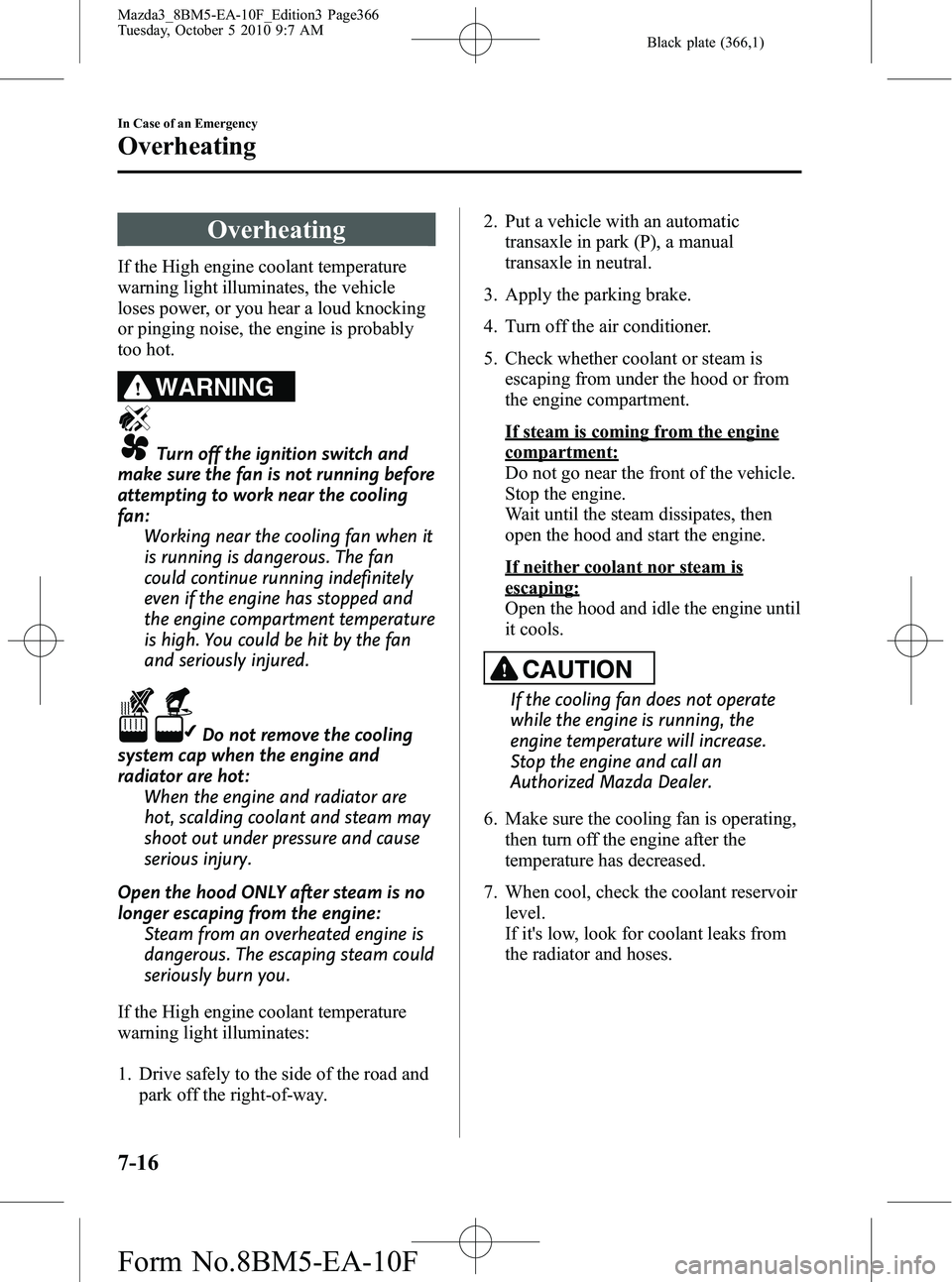stop start MAZDA MODEL 3 4-DOOR 2011 Owner's Guide
[x] Cancel search | Manufacturer: MAZDA, Model Year: 2011, Model line: MODEL 3 4-DOOR, Model: MAZDA MODEL 3 4-DOOR 2011Pages: 514, PDF Size: 6.58 MB
Page 366 of 514

Black plate (366,1)
Overheating
If the High engine coolant temperature
warning light illuminates, the vehicle
loses power, or you hear a loud knocking
or pinging noise, the engine is probably
too hot.
WARNING
Turn off the ignition switch and
make sure the fan is not running before
attempting to work near the cooling
fan: Working near the cooling fan when it
is running is dangerous. The fan
could continue running indefinitely
even if the engine has stopped and
the engine compartment temperature
is high. You could be hit by the fan
and seriously injured.
Do not remove the cooling
system cap when the engine and
radiator are hot:
When the engine and radiator are
hot, scalding coolant and steam may
shoot out under pressure and cause
serious injury.
Open the hood ONLY after steam is no
longer escaping from the engine: Steam from an overheated engine is
dangerous. The escaping steam could
seriously burn you.
If the High engine coolant temperature
warning light illuminates:
1. Drive safely to the side of the road and park off the right-of-way. 2. Put a vehicle with an automatic
transaxle in park (P), a manual
transaxle in neutral.
3. Apply the parking brake.
4. Turn off the air conditioner.
5. Check whether coolant or steam is escaping from under the hood or from
the engine compartment.
If steam is coming from the engine
compartment:
Do not go near the front of the vehicle.
Stop the engine.
Wait until the steam dissipates, then
open the hood and start the engine.
If neither coolant nor steam is
escaping:
Open the hood and idle the engine until
it cools.
CAUTION
If the cooling fan does not operate
while the engine is running, the
engine temperature will increase.
Stop the engine and call an
Authorized Mazda Dealer.
6. Make sure the cooling fan is operating, then turn off the engine after the
temperature has decreased.
7. When cool, check the coolant reservoir level.
If it's low, look for coolant leaks from
the radiator and hoses.
7-16
In Case of an Emergency
Overheating
Mazda3_8BM5-EA-10F_Edition3 Page366
Tuesday, October 5 2010 9:7 AM
Form No.8BM5-EA-10F
Page 403 of 514

Black plate (403,1)
4. While the engine is still idling, pull outthe dipstick and wipe it clean, and then
put it back.
5. Check the ATF level. If there is no ATF adhering 5 mm from the end of the
dipstick, add ATF.
CAUTION
If there is no ATF adhering to the
dipstick even after the engine has
been warmed up, do not drive the
vehicle. Otherwise, the automatic
transaxle could be damaged.
6. Shift the shift lever to each range and position, and make sure there is no
abnormality.
7. Drive the vehicle on city roads for 5 km (3.1 mile) or more.
8. Park on a level surface and set the parking brake firmly.
9. Shift the shift lever to the park position (P), check the ATF level while the
engine is idling, and make sure that the
ATF level is within the proper level. If
the ATF level is not within the proper
level, add ATF. The proper fluid level
is marked on the dipstick as follows.
Full
OK
Low
CAUTION
Ø Use the cold scale only as a
reference.
Ø If outside temperature is lower
than about 20 °C (70 °F), start the
engine and inspect the fluid level
after the engine reaches operating
temperature.
Ø If the vehicle has been driven for
an extended period at high speeds
or in city traffic in hot weather,
inspect the level only after
stopping the engine and allowing
the fluid to cool for 30 minutes.
Fully insert the dipstick. When adding
fluid, inspect with the dipstick to make
sure it does not pass full.
NOTE
Inspect the fluid on both sides of the dipstick in
a well lit area for an accurate reading.
Maintenance and Care
Owner Maintenance
8-25
Mazda3_8BM5-EA-10F_Edition3 Page403
Tuesday, October 5 2010 9:7 AM
Form No.8BM5-EA-10F
Page 480 of 514

Black plate (480,1)
NOTE
Tires degrade over time, even when they are not being used on the road. It is recommended that tires
generally be replaced when they are 6 years or older. Heat caused by hot climates or frequent high
loading conditions can accelerate the aging process. You should replace the spare tire when you
replace the other road tires due to the aging of the spare tire. The period in which the tire was
manufactured (both week and year) is indicated by a 4-digit number.
Refer to The tire labeling on page 9-23.
qSafety Practices
The way you drive has a great deal to do with your tire mileage and safety. So cultivate
good driving habits for your own benefit.
lObserve posted speed limitslAvoid fast starts, stops and turnslAvoid potholes and objects on the roadlDo not run over curbs or hit the tire against the curb when parking
CAUTION
If you feel a sudden vibration or ride disturbance while driving or you suspect your
tire or vehicle has been damaged, immediately reduce your speed. Drive with caution
until you can safely pull off the road. Stop and inspect the tire for damage. If the tire
is under-inflated or damaged, deflate it, remove the tire and rim and replace it with
your spare tire. If you cannot detect a cause, have the vehicle towed to the nearest
vehicle or tire dealer to have the vehicle inspected.
9-34
Customer Information
Tire Information (U.S.A.)
Mazda3_8BM5-EA-10F_Edition3 Page480
Tuesday, October 5 2010 9:8 AM
Form No.8BM5-EA-10F